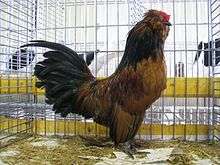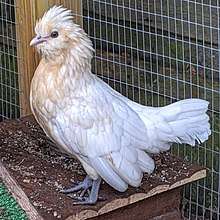Barbu de Watermael
The Barbu de Watermael, Dutch: Watermaalse Baardkriel, is a Belgian breed of bantam chicken. It originated in the Belgian town of Watermael-Boitsfort (Dutch: Watermaal-Bosvoorde), from which it takes its name, which means "bearded [chicken] from Watermael". It is closely related to the Barbu d'Anvers, but is distinguished from it by its small, backswept crest of feathers. The Barbu de Boitsfort is a rumpless variation, the only difference being that it lacks the uropygium, the part of the anatomy that carries the tail.[1]
 | |
| Conservation status | endangered |
|---|---|
| Other names | Dutch: Watermaalse Baardkriel |
| Country of origin | Belgium |
| Use | fancy |
| Traits | |
| Weight | |
| Comb type | spined rose[2] |
| Classification | |
| |

History
The Barbu de Watermael is among the most recent of Belgian bantam breeds, but its origin is poorly documented. It was created by Antoine Dresse at the estate of La Fougères at Watermael-Boitsfort in the early years of the twentieth century, or, according to one source, in 1915. Neither Dresse nor his son ever revealed what breeds contributed to the creation of the Barbu de Watermael, though the contribution of the Barbu d'Anvers is considered certain. Dresse did say that the Polish had not been used; the cranial protuberance typical of that breed is considered a fault in the Barbu de Watermael.[1][3]:71 The birds were first shown in 1922, but did not achieve great popularity. A breeders' club was formed in France after the Second World War, and another, the Watermaalse Baardkrielclub, in the Netherlands in 1971.[1][4]
In number, the Barbu de Watermael is today the second bantam breed in Belgium, with a population of 764 in 2010; it was classed as "in danger" in that year.[1]
Characteristics
The Barbu de Watermael is one of the smallest of all bantams: males weigh 600–700 g and hens 450–550 g.[2] It has a narrow backswept crest, a three-part beard and a unique spined rose comb. It is raised almost exclusively as an ornamental fowl. More than thirty colour varieties are recognised in Belgium. Those usually seen are black, brown red, buff Columbia, cuckoo, quail and white; the other colours are rare, and some are in the hands of only one breeder.[1]
References
| Wikimedia Commons has media related to Barbu de Watermael. |
- N. Moula, M. Jacquet, A. Verelst, N. Antoine-Moussiaux, F. Farnir, P. Leroy (2012). Les races de poules belges (in French). Annales de Médecine Vétérinaire 156: 37-65. Accessed August 2014.
- Watermaalse baardkriel (in Dutch). Zeldzame Oorspronkelijke Belgische Krielhoenderrassen. Accessed August 2014.
- Victoria Roberts (2008). British Poultry Standards: Complete specifications and judging points of all standardized breeds and varieties of poultry as compiled by the specialist breed clubs and recognised by the Poultry Club of Great Britain. Oxford: Blackwell. ISBN 9781405156424.
- Eerste periode van 1971 – september 1984: de Watermaalse baardkrielclub (in Dutch). Zeldzame Oorspronkelijke Belgische Krielhoenderrassen. Accessed August 2014.